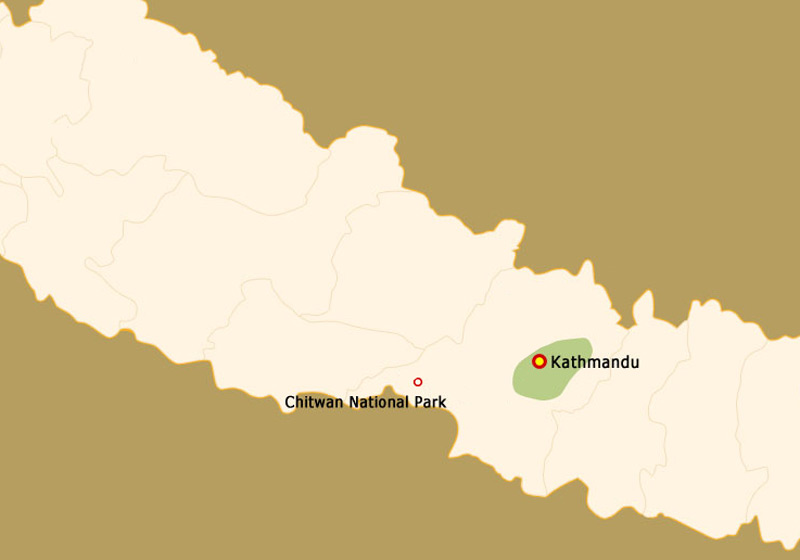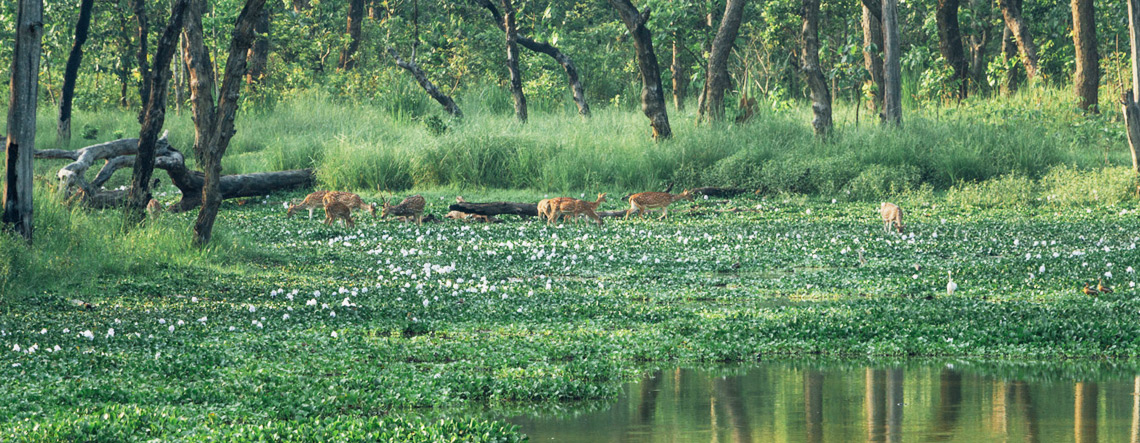
Chitwan National Park Travel Guide
The southern part of Nepal is extensive plain, where the river forms alluvial fans, nourishing fertile soil and water. As a result, a wide range of wildlife habitat and lush jungles appear. This is Chitwan. Since the late 19th century, Chitwan was used to be a hunting ground for Nepal’s royal during the winter time. They set up camps here for the feudal big game hunter. In 1950, the forest of Chitwan extended and some poor farmers came there for settlement. In 1973, Chitwan National Park - the first national park of Nepal was established and 11 years later it was listed in the World Heritage Sites. Now it covers an area of 932 square kilometers (360 square miles).
Chitwan – Home to Sizeable Wildlife Populations
Literally, Chit means “heart” and Wan means “jungle” in Nepalese language. Just as its name suggests, Chitwan is Heart of the Jungle. Various wild animals live harmoniously with each other. Numerous tourists flocked there to enjoy the wildlife charm. In the national park, you will get an excellent opportunity to spot sloth bears, one-horned rhinos, wild elephant, and Royal Bengal tiger and up to 500 species of birds. More that sightseeing, it is also available to get a close contact with wild nature, like riding an elephant, doing a nature walk, or taking a jungle drive.
Highlights of Chitwan National Park
As a well-known tourist destination, Chitwan attracts people with its ecosystems, including the Churia hills, Ox-bow lakes, and the flood plains of the Rapti, Reu and Narayani Rivers. Walking into the Chitwan National Park, you can feel the great enjoyment of viewing the primitive nature and watching a diversity of wild animals.

-
Elephant Ride
Type: Leisure & Outdoor
Recommended Length of Visit: 2 hrs
How about a ride on an elephant’s back in the dense forest viewing the wildest of wildlife activities? Don’t you wish that there be an Elephant breeding center to breed and rear these gigantic mammals before extinction? Yes, and it’s an opportunity not to be missed, to go in depth about their reproducing behavior.

-
Bird Watching
Type: Leisure & Outdoor
Recommended Length of Visit: 1 hr
The Chitwan National Park is the realm of more than 500 species of birds, in other words, some people have commented the park as a heaven of the bird world. Take a guided tour through the forest to hear the colorful birds’ early morning chirps and hand in hand goes the beauty of the dawn. Bring your camera and take some nice pictures.

-
Nature Walk
Type: Walking
Recommended Length of Visit: 2 hrs
Jungle Walks allows one to explore several different habitat areas, from the flood-plain grassland to the dense Sal forests, where one gets an opportunity to encounter different animals in front. Since it disturbs the animals less to walk through the forest, it is usually a better chance for discovering wildlife. You can learn much.

-
Dugout Canoe Ride
Type: White-water Rafting
Recommended Length of Visit: 1 hr
Floating down to Rapti River on a dugout canoe is the best way to discover the habitat of crocodiles in the river. It is also a relaxing and better way to watch the different kind of birds and wildlife species, while they are drinking water in the bank of river Rapti. Floating on the river freely, you will forget the uproariousness of the outside world.
How to Get to Chitwan National Park
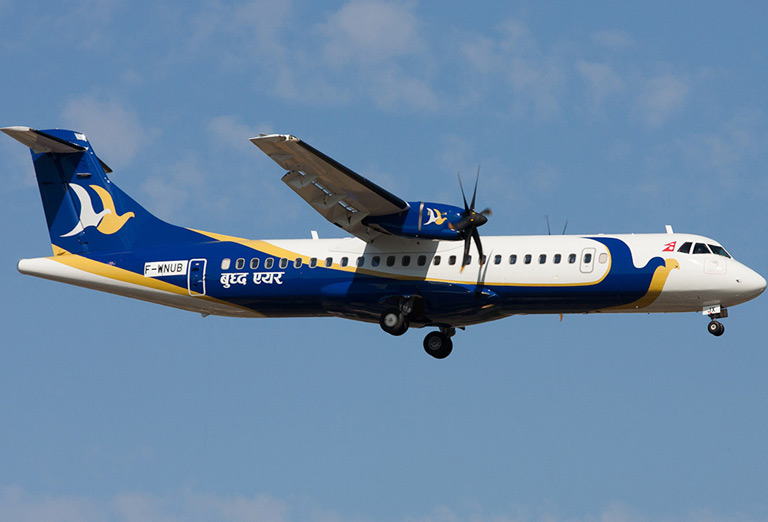
-
Travelers unusually transfer to Chitwan National Park after their Kathmandu tour. Chitwan National Park is 150km away southwest from Kathmandu, and there are two transportation means to get there.
Kathmandu Bharatpur Flight: There are 2 daily flights running between Kathmandu Tribhuvan International Airport and Bharatpur Airport in Chitwan usually, taking only about 40 minutes. As you land off, it needs another 40 minutes’ driving to reach Chitwan National Park.
Kathmandu Chitwan Driving: More people prefer driving to Chitwan from Kathmandu, for the driving journey always provides a good opportunity to appreciate the scenery on the road. 5 hours will be spent in driving in the mountains. There are tourist buses departing from the Thamel end of Kantipath in Kathmandu at around 7am and it takes 5~7 hours to get to Chitwan National park.
Best Time to Visit Chitwan National Park
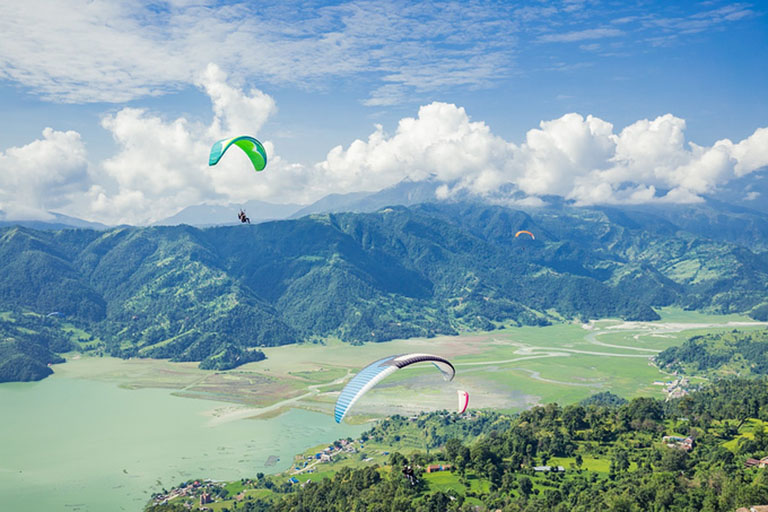
-
Located in the central climatic zone of the Himalaya ranges, Chitwan enjoys a tropical monsoon climate with high humidity all the year around. The monsoon starts in mid-June and lasts for about 3 months. During this period, there will be pouring with rain. Winter lasts from October to late February. January is the coldest month, with temperature declining to freezing-point. Then, the temperature rises gradually. The warm seasons begin from March to early June, and temperature rises progressively to a peak in May.
The best time for Chitwan National Park includes February ~ April and October ~ December. In the spring, the national park offers a good view of wildlife for the villages cut thatch grasses in the late January usually. During October to December, you can admire the beauty of the Himalayan Ranges clearly. There might be cold in the morning and evening, bring some thick coat to keep you warm.
Where to Accommodate in Chitwan National Park
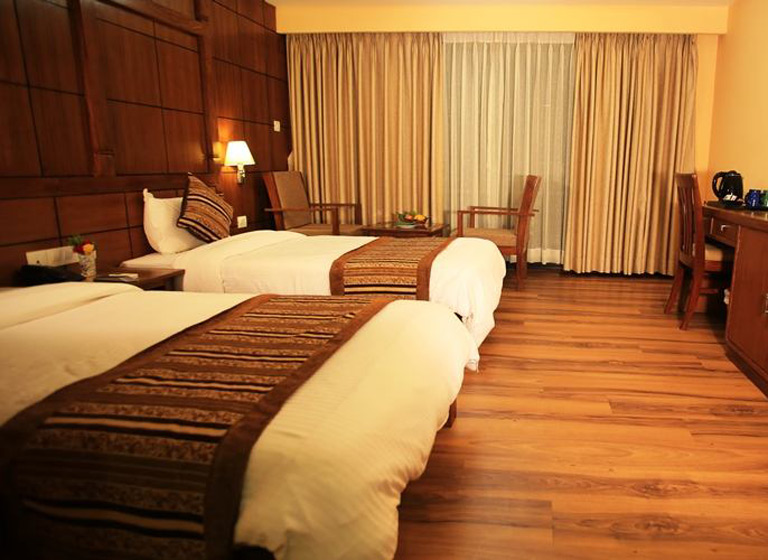
-
With lots of tourists coming to enjoy the original nature and wildlife, Chitwan is developed with enough accommodating places ranging from several luxury resorts to delicate resorts for your choice. Most of them provide comfortable rooms, pleasant service, Free Wi-Fi, Nepalese breakfast etc. We have selected some good hotels according to the tourists’ feedbacks on TripAdvisor.
Landmark Forest Park: Located in the Chitwan National Park, Landmark Forest Park is a modern hotel with excellent rooms and helpful staff. There is a resaonably priced restaurant serving great local and international dishes.
Hotel Seven Star: Within only 10 minutes’ walk to the main street, Hotel Seven Star has a chilled and relaxing location. Rooms are very comfortable, and the food is amazing.
Green Park Chitwan: Green Park Chitwan is a 4-star hotel offering cozy rooms with fridge, minibar, air-condition, hot water, TV, tea & coffee making facilities. Pick up/drop off from airport is available. Exceptional service and great team work make this hotel popular.
Useful Nepal Travel Notes
- 1. How to Plan Nepal Travel
- Usually, tourists take about 4~15 days to have a classic Nepal tour. Most of them start their Nepal tour from the capital city – Kathmandu. Four days are recommended to explore the highlights of Kathmandu Valley. Then, you can extend your tour to a deep nature or culture exploration. One more day allows you to have a great view of Mount Everest in Nagarkot. With 2~3 more days, you can turn to Pokhara for the picturesque natural landscape or Chitwan National park for the great wildlife adventure – both of them are recommended. If you are interested in Buddhist culture, Lumbini – the birthplace of the Lord Buddha, can’t be missed. You are suggested to spend 9 days to have a full Buddhist tour from Kathmandu Valley to Dhulikhel, Lumbin, Bharktapur, and Pharping. If you want to stretch your legs, a 9 days Poon Hill Trekking will be amazing. In fact, many tourists choose to have a tour combining Nepal and Tibet. After you Nepal Tour, you can get to Tibet through Gyirong Airport which was newly open to foreign travelers in 2017. After that, you can drive to Mount Everest, Mount Kailash or Lhasa. It is also available to take a nonstop flight to Lhasa from Kathmandu.
- 2. What to Pack
- For foreign travelers to Nepal, documents – valid passport and Nepal Visa are the most important to pack. Then, you are suggested to take a large backpack for big luggage and a smaller bag for valuables. Traveling in Nepal during summer times, rain gears are necessary while warm clothing is must when you travel in winter. If you plan a trekking tour in Nepal, take both light and warm clothing in casual styles because you will experience a wide range of climates. Good windproof and waterproof jacket, walking boots with ankle support are must.
- 3. How to Get to Nepal
- At present, Nepal can be reached by flights and overland driving. Kathmandu Tribhuvan International Airport is the only international airport in Nepal, connected with many cities, like Bangkok, Colombo, Calcutta, Delhi, Dhaka, Abu Dhabi, Dubai, Frankfurt, Hong Kong, Karachi, Lhasa, London Osaka, Paris, Moscow, Paro, Singapore and Varanasi. If you feel to find available flights from your country to Nepal, it will be a good idea to travel China first. After your China mainland tours, you can easily get to Tibet by flight or driving, then have an unforgettable overland driving experience to Nepal across Gyirong Airport.
- 4. What to Eat in Nepal
- Heavily influenced by Indian and Tibet dishes, Nepal food is quick to cook and tasty to eat. The most popular Nepal food is a dish called “Daal, Bhaat and Tarkaari” (lentils, rice, vegetable curry respectively). This is the main course served in the most Nepalese houses regardless of the economic conditions, that too in both lunch and as well as dinner. Kathmandu is a melting pot of international cuisine. Besides Nepal food, Nepal restaurants here serve varieties of hygienic delicacies from Indian, Chinese, Tibetan, Japanese, Italian, Australian, Russian, Korean, and Mexican etc to Continental at remarkably reasonable price.
Most Recommended Chitwan Tour Packages
Following are some other recommended Chitwan tour packages that you may be interested in. All of our Nepal tour packages are customizable to meet your personal requirements. You can also contact us to customize a trip if you want.
-

8 Days Kathmandu Pokhara Chitwan Highlights Tour
Kathmandu / Nagarkot / Pokhara / Chitwan / Kathmandu
-

10 Days Nepal Natural and Cultural Savory Tour
Kathmandu / Pokhara / Lumbini / Chitwan / Nagarkot / Kathmandu
-


